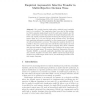Free Online Productivity Tools
i2Speak
i2Symbol
i2OCR
iTex2Img
iWeb2Print
iWeb2Shot
i2Type
iPdf2Split
iPdf2Merge
i2Bopomofo
i2Arabic
i2Style
i2Image
i2PDF
iLatex2Rtf
Sci2ools
DIS
2008
Springer
2008
Springer
Empirical Asymmetric Selective Transfer in Multi-objective Decision Trees
We consider learning tasks where multiple target variables need to be predicted. Two approaches have been used in this setting: (a) build a separate single-target model for each target variable, and (b) build a multi-target model that predicts all targets simultaneously; the latter may exploit potential dependencies among the targets. For a given target, either (a) or (b) can yield the most accurate model. This shows that exploiting information available in other targets may be beneficial as well as detrimental to accuracy. This raises the question whether it is possible to find, for a given target (we call this the main target), the best subset of the other targets (the support targets) that, when combined with the main target in a multi-target model, results in the most accurate model for the main target. We propose Empirical Asymmetric Selective Transfer (EAST), a generally applicable algorithm that approximates such a subset. Applied to decision trees, EAST outperforms single-tar...
| Added | 09 Nov 2010 |
| Updated | 09 Nov 2010 |
| Type | Conference |
| Year | 2008 |
| Where | DIS |
| Authors | Beau Piccart, Jan Struyf, Hendrik Blockeel |
Comments (0)

